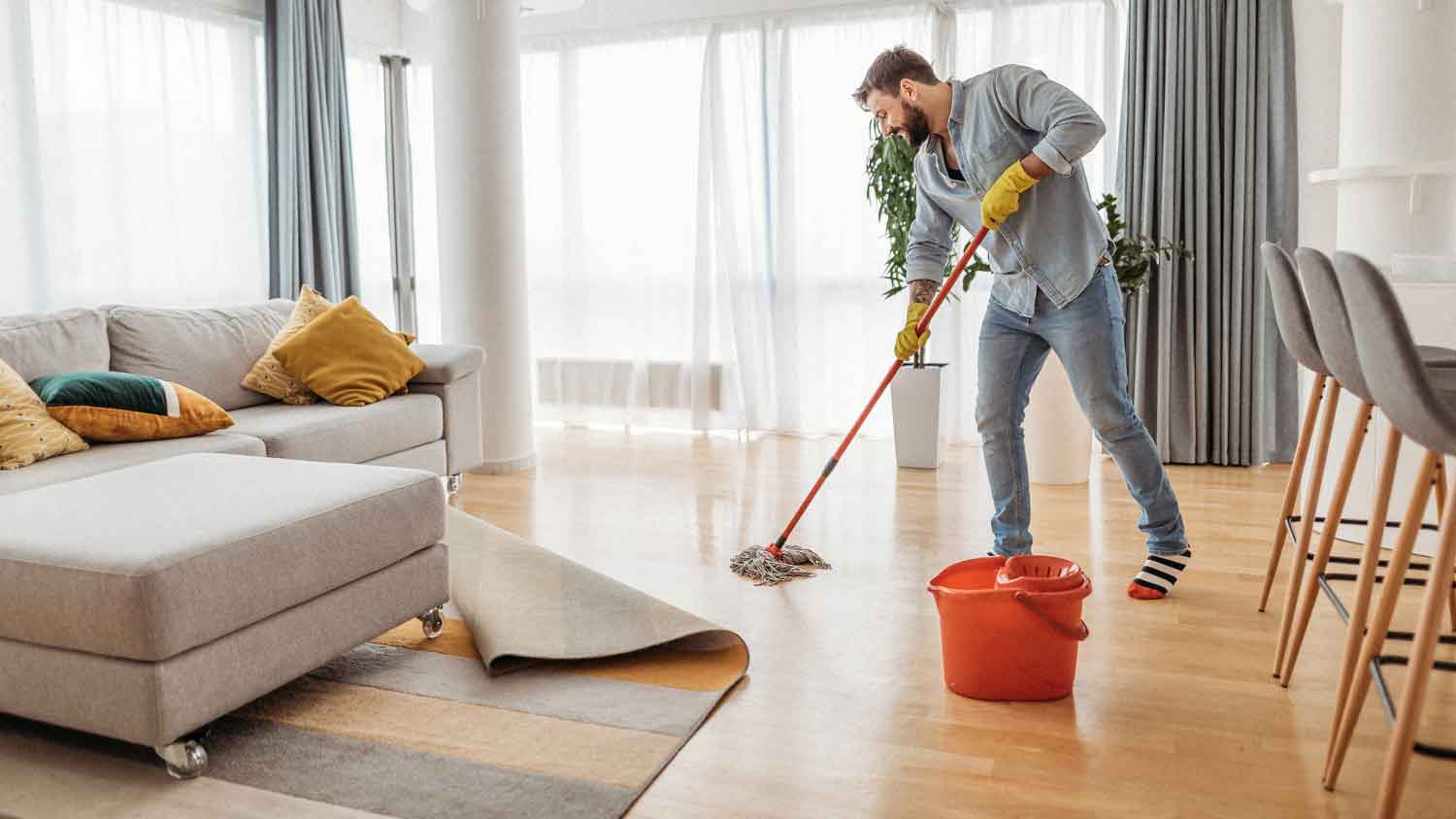How to Clean Baseboards Easily
Clean baseboards lay the groundwork for a clean room


Every time you dust the ceilings, walls, or bookshelves, all that extra dirt floats to the floor. And while it may seem like it just magically disappears, it often catches on the baseboards. Cleaning your baseboards about once a month is one of those home cleaning tricks that makes a room look polished and tidy. Thankfully, learning how to clean baseboards is quite straightforward, and there are plenty of tips to get it done quickly and effectively.
What Are Baseboards, and Why Should I Clean Them?
A baseboard is the wood or fiberboard trim that runs along the joint where the wall meets the floor. Similar to crown molding that connects the wall and ceiling or the frames that surround your doors and windows, a baseboard provides an outlined, clean look to a room.
In addition to looking stylish, a baseboard protects the bottom of the wall from furniture, shoes, and other items that could bump or scratch this vulnerable area. But this placement means that they are also prone to scuffs, scratches, and—the biggest baseboard headache—falling dust. Knowing how to clean baseboards will keep your home looking fresh and take care of the important buffer between your floorboards and walls.
How to Prep Your Baseboards for Cleaning
Begin by checking whether your baseboards are painted or stained. If they are painted, feel the baseboard for the type of paint sheen used by the last painters. Semi-gloss or high-gloss paints are popular baseboard options. You'll need to choose the right cleaning supplies for the type of paint on your baseboards. Similarly, if you're working with a stained variety of wood, it's best to use a wood-safe cleaner.
One golden rule of cleaning is to start with the top and work your way down. Otherwise, you'll end up cleaning the bottom of the room several times as dirt and dust fall from above. The same rule applies to your baseboards. Be sure to clean all ceiling fans, ceilings, walls, and shelves before tackling the floor and baseboard. Also, clean the baseboards one room at a time, so you don’t get overwhelmed by the project.
How to Clean Baseboards

There's a big difference between wiping off a layer of dust and deep cleaning your baseboards. Keep your baseboards looking sharp by dusting them as often as you vacuum each room. Deep cleans are often only necessary once every few months or when working through a thorough spring cleaning checklist.
Vacuum With a Brush Attachment
Start by removing large dust bunnies, bits of grit from your shoes, and occasional cobwebs that build up on baseboards. Many vacuum cleaners feature a small brush attachment that connects to the bottom of the main rod. Run the vacuum brush along the top and bottom of your baseboards, as well as along any crevices in the design.
Dust With a Long Microfiber Mop
Flat microfiber mops are a great way to grab any loose dust if you either don't have a vacuum handy or if the vacuum misses the sheen of dry dust on its surface. If the mop doesn't allow you to get into all the crevices, it's time to get down at eye level with the baseboard and use the microfiber cloth for a closer clean.
Dust With a Dryer Sheet
Here's a fun trick for your cleaning rounds: Dryer sheets can replace microfiber dust-free cloths and keep dust away in the future. The dryer sheet leaves a static-fighting residue on your baseboard, deterring dust from building up right away. Run the sheet along the baseboard by hand after you've cleaned it with the vacuum, or attach it to the end of a flat mop for less bending. Opting for a dryer sheet is a safe tip for cleaning antique wood as well since it is both gentle and efficient at picking up dust.
Wipe Down With Dish Soap
A solution of dish soap and warm water—a few drops in a gallon of water will do—is safe on both stained wood and painted baseboards. You can even use gentle dish soap and water when cleaning walls with flat paint.
Apply the damp solution to the cleaning cloth and wipe off the sticky residue, scuff marks, or stubborn grit that didn't come off during dusting. The gentle solution is also safe if you have hardwood floors beneath your baseboards. Just be sure to keep water from pooling on the floor.
Make a Vinegar Solution
There are many clever ways you can use vinegar around the house, and a vinegar-water solution is also great on baseboards. A half cup of white distilled vinegar is best mixed with a gallon of warm water. You can even add a few drops of dish soap to break down tricky stains. White vinegar is also an option if you're learning how to clean soot off wood, either from the fireplace or candles.
Vinegar can be harsh on unsealed wood, so we recommend testing a bit of the solution in an inconspicuous area before washing the whole baseboard. And as before, avoid letting the water run down and pool on the floors, especially if you have hardwood boards.
Use a Clean Sock
If you're short on cleaning tools, there are plenty of creative solutions. For example, attach a clean sock you're comfortable sacrificing to the end of a broomstick. A few rubber bands should do it. You can also use a thin dishrag or cleaning cloth if you have those handy.
Run the sock along the baseboards for a quick dusting or dampen it with a cleaning solution for a deeper clean. The point of the sock trick? It helps you avoid bending over or crawling on the ground if you don't have a mop.
Detail With Cotton Swabs
Intricately carved baseboards can accumulate dust in between their crevices. Dust particularly likes to build up in the corners of rooms. If you're performing a deep clean across your house, break out the cotton swabs and dip them in a bit of dish soap and water to focus on the tough spots.
Consider Commercial Cleaners
All-purpose and oil-based wood cleaners are appropriate for painted and stained wood baseboards if—and only if—the bottle indicates that it is safe on porous materials. In many cases, the cleaner will call for a damp cloth or for diluting the solution. As you did with the vinegar solution, test each new product in a specific area before washing the whole board.
Use a Broom
If you're low on time but just need to get the job done, swipe a broom across the border of each room to clean your baseboards. Turn the broom at a 45-degree angle to get a clean sweep. Make sure the broom is clean, as dirty bristles can spread dust and pet hair further by using this method. You may need to bring in a damp microfiber cloth to get the stuck-on dust and grit, but a broom is the easiest baseboard cleaning method to pair with your other chores.
Tips for Keeping Baseboards Clean
Baseboards are one of those spots in your house you often forget about until you kneel down to pick something up and get a look at some dust bunnies. Here are some tips to prevent dust and grime from building up on your baseboards over time.
Take your shoes off when you come inside the house.
Designate shoes and coat storage to one area of the house to avoid spreading grit.
Prop an extendable mop in rooms that collect dust frequently.
Dust the baseboards each time you sweep or vacuum the room.
Focus on mudrooms, playrooms, and areas with hanging plants more frequently.
Address any repairs in your baseboards as soon as you see a crack, scratch, or dent.
Every few years, you may have more luck painting your baseboards with a fresh coat, especially if those stains and scuff marks just won't go. Hiring a local handyperson can also assist in reattaching, replacing, or repairing cracks on your baseboard.
DIY vs. Hiring a Pro to Clean Baseboards
Cleaning baseboards is a low-cost and easy DIY job, but it can be time-consuming. Typically, the more you clean the rest of your house, the more dust falls and sticks to your baseboards. That being said, it's easy to add it to your usual routine.
Hiring a professional house cleaner costs between $30 and $50 per hour. Since cleaning your baseboards is an ongoing project, you're more likely to set up recurring visits or pay extra for this deep cleaning. These can cost $75 to $200 for weekly visits or $100 to $250 for biweekly visits. More specifically, if you hire a local house cleaner to clean your walls and baseboards, wall cleaning costs throughout your home will average about $300.
The cost to replace baseboards, however, will run you $6 to $9 per linear foot for materials and an additional $50 to $100 per hour for labor.
Frequently Asked Questions
To determine whether you can use cleaning wipes on baseboards, figure out if your trim and baseboards are painted or stained. Painted baseboards can often handle wipes that contain bleach or similar disinfectant. However, steer clear of using these wipes on unfinished wood baseboards, especially if you use them regularly.
Yes, clean baseboards with a retractable flat broom or mop or a vacuum with a long brush attachment if you're trying to avoid bending over to reach your baseboards. You can also attach a cloth or a clean sponge dipped in a cleaning solution to the end of a broomstick to reach your baseboards without straining your back.
Clean baseboards about once a month alongside the rest of your monthly home cleaning checklist. Dust likes to tumble from the ceilings, walls, and drapes to the floor but often gets caught on the baseboard on its way down. Remove loose dust at least once a month and give it a deeper scrub during your annual spring cleaning.





- How to Fix Water Damage on Baseboards
- 11 Types of Baseboards and How to Choose the Best One
- Who to Hire to Replace Baseboards in Your Home
- Gluing vs. Nailing Baseboards: Which Is Right for Your Project?
- Learn How to Clean Your House (and Maybe Even Have Fun Doing It) With These 27 Tips
- 5 Alternatives to Baseboards That Don’t Skimp on Charm
- The Ultimate Room-by-Room Spring Cleaning Checklist
- How Do You Fix Issues With Trim and Moldings?
- These Are the Best Tools for Cleaning Hard-to-Reach Areas
- 26 House Cleaning Tips to Elevate Your Cleaning Game









